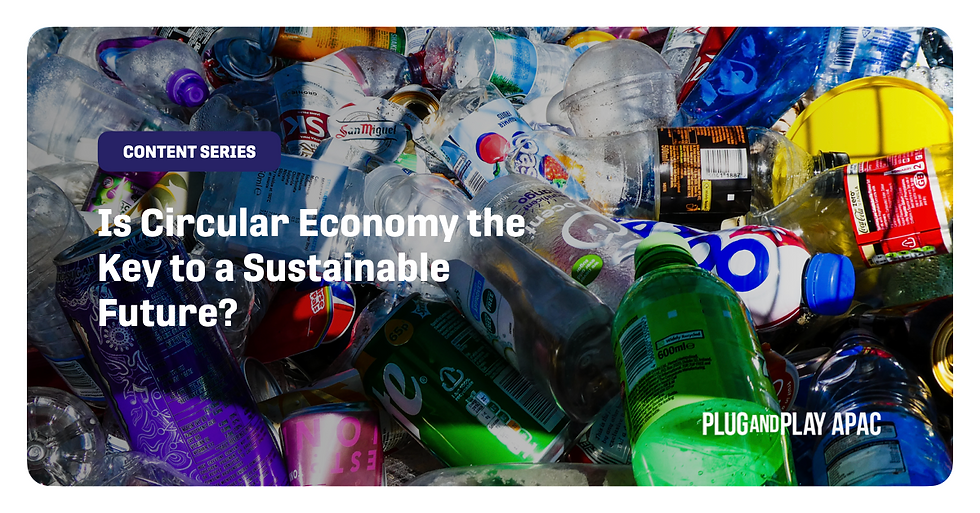Is Circular Economy the Key to a Sustainable Future?
- tgeoerge
- Apr 28, 2023
- 4 min read
Updated: Feb 14, 2024

As the world faces an unprecedented challenge of environmental degradation and depletion of natural resources, the need for a sustainable economic model is more pressing than ever.
The traditional linear economy, where we take, make, and dispose of products, has proven to be unsustainable, leading to resource depletion and environmental degradation.
This has given rise to the concept of a circular economy, which aims to keep resources in use for as long as possible by minimizing waste and promoting the reuse, repair, and recycling of products. But is a circular economy the key to a sustainable future?
Today, we will explore the concept of circular economy and its potential to create a sustainable future.
What is a Circular Economy?
A circular economy is an economic model that aims to keep resources in use for as long as possible by promoting the reuse, repair, and recycling of products.
In a circular economy, waste is minimized, and resources are conserved, by using materials for as long as possible and recovering and regenerating products and materials at the end of their useful life. This means that products are designed for longevity and resource efficiency, with the aim of reducing waste and maximizing resource use.
The circular economy is based on three principles: designing out waste and pollution, keeping products and materials in use, and regenerating natural systems.
By implementing these principles, we can create a more sustainable economic model that is capable of meeting our needs without compromising the ability of future generations to meet their own needs.
Why Do We Need a Circular Economy?
The traditional linear economy is based on a "take-make-dispose" model, where raw materials are extracted, processed into products, and then disposed of at the end of their useful life. This model is unsustainable because it leads to resource depletion and environmental degradation.
As the global population grows and consumption patterns change, the demand for natural resources continues to increase, placing even more pressure on the environment.
A circular economy offers a sustainable alternative to the linear economy by minimizing waste and maximizing resource use.
By designing products for longevity and resource efficiency, we can reduce the amount of waste generated and conserve resources for future generations. By keeping products and materials in use for as long as possible, we can reduce the need for virgin resources and minimize the environmental impact of resource extraction.
A Circular Economy Can Unlock a More Sustainable Future
The concept of a circular economy is not new. Over the years, its adoption has steadily increased as numerous enterprises, governing bodies, and institutions have recognized the potential advantages that a circular economy can offer.
Reduction in Waste and Pollution
A circular economy primarily contributes to the reduction of waste and pollution. By maximizing the use of resources and minimizing waste production, a circular economy can decrease the volume of waste that ends up in landfills, oceans, and other natural habitats.
Consequently, this can mitigate the environmental damage caused by unsustainable consumption and production patterns and safeguard natural ecosystems.
Environmental Conservation
A circular economy can also help to conserve natural resources. By extending the lifespan of products and materials, a circular economy can reduce the need for new resources to be extracted from the earth.
This, in turn, can help to conserve resources like water, energy, and minerals, which are becoming increasingly scarce and valuable.
Economic Benefits
By eliminating waste and pollution, companies can reduce their costs and enhance their efficiency. And, by keeping products and materials in use for longer, businesses can also create new revenue streams and business models, such as product-as-a-service or leasing arrangements.
Apart from tangible economic gains, a circular economy can help to create new jobs and stimulate economic growth. As the transition towards a circular economy requires new skills and expertise, it can create opportunities for innovation and entrepreneurship.
In fact, a report by The European Parliament estimated that a transition to a circular economy could create 1.2 million new jobs in Europe alone by 2030.
Circulor, A Startup Bringing Transparency to Global Supply Chains
Circulor is among the pioneering startups dedicated to realizing the vision of a circular economy.
The startup leverages technologies like blockchain, IoT, and AI to provide end-to-end traceability across complex industrial supply chains. The Circulor platform enables manufacturers and their suppliers to track raw materials from their origin to the finished product, thus supporting the transition to a more sustainable future.
As a result, Circulor empowers its customers to demonstrate responsible sourcing, monitor and reduce inherited emissions from the supply chain, and lay the foundation for their circular economy goals.
Conclusion
A circular economy offers a promising pathway toward a more sustainable future. By rethinking our current linear economy and transitioning towards circular business models and practices, we can reduce waste, conserve resources, and create economic opportunities.
While the transition to a circular economy may not be easy, it is necessary if we are to address the environmental challenges we face. Achieving the full potential of the circular economy requires a concerted effort from all stakeholders, including governments, businesses, and consumers.
By fostering cooperation, innovation, and education, we can establish a more circular and sustainable economy that benefits both current and future generations.
ARTICLE WRITTEN AND COMPILED BY: PLUG AND PLAY APAC
As an in-house venture capital, our goal is to fund the teams that are building the defensible businesses of the future. By leveraging our capital, our network of VCs, and our corporate partners, we give our portfolio companies an added advantage. Join our platform today!



